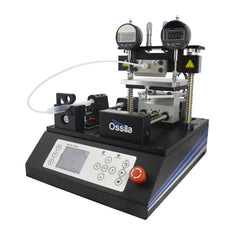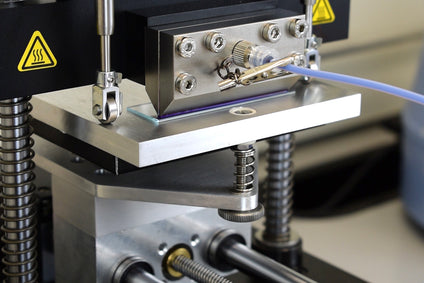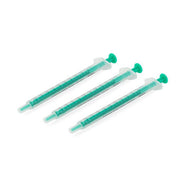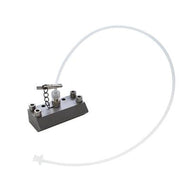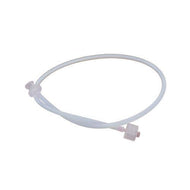
Type G
Used in the UK, Ireland, Saudi Arabia, Hong Kong, and the UAE.

Type F
Used in the EU (except Ireland), Korea, Russia, Egypt, and mainland China.
Type B
Used in the USA, Canada, Japan, Taiwan, Mexico, and mainland China.

Type I
Used in Australia, New Zealand, and mainland China.
Country not listed? We ship worldwide. Please contact us if you are not sure which plug type you need.
Precision Slot Die Coating for All Laboratories
Scale up your thin film processing with our compact and affordable slot die coater
Overview | Specifications | Features | Gallery | In the Box | Accessories
Smaller than other models on the market, but just as precise. The Ossila Slot Die Coater is a complete slot die system, including an integrated syringe pump for synchronised start and end times.
Our slot die coater is fully operable using the digital controls. You can easily program multi-step processes to independently control the temperature, substrate speed, alignment, solution flow rate, channel thickness, head height, and more. Save 20 of these programmes, each with up to 50 steps, for easy and repeatable experiments.
Designed for beginners and experts, our slot die coater is covered by our two-year warranty and eligible for free worldwide shipping. Order your slot die coater today to scale up your thin film processing.
Precision Alignment
3-point levelling system
Space-Saving Design
Fits in any lab set up
Quick Set Up
Plug in and start immediately
High Uniformity
Achieve highly even coatings
Easy to Use
User friendly design
Low Operating Costs
Low energy consumption

Lab Proof
Durable design to last

Two-Year Warranty
Buy with confidence
Specifications
| Maximum Hotplate Temperature | 120 °C (248 °F) |
|---|---|
| Stage Surface Roughness (RMS) | <3 μm* |
| Stage Surface Flatness | <20 μm* |
| Linear Motion Levelness | <50 μm variation over 100 mm (0.05%)* |
| Stage Travel Length | 100 mm (maximum) |
| Minimum Stage Speed | 100 μm.s-1 |
| Maximum Stage Speed | 50 mm.s-1 |
| Maximum Head to Substrate Travel Distance | 13 mm |
| Power Supply | DC 24 V, 6.2 A, via 100 – 240 V 50/60 Hz power adapter |
| Dimensions (D x W x H) | 360 mm x 280 mm x 190 mm (14.2" x 11" x 7.5") |
| Weight | 9.2 kg |
* Values determined at a stage temperature of 21 °C (69.8 °F).
Slot Die Coater Features
Variable Channel Thickness
Increase the range of different solutions that can be processed with a single slot die head. Interchangeable stainless steel shims give you control to change the thickness of the slot die channel in intervals of 100μm.
Uniform Flow Rates and Thicknesses
The Ossila Slot Die Coater has an integrated syringe pump for accurate and repeatable film thicknesses. You can precisely control the amount of solution entering the system. Plus, the in-built software makes programming synchronised starting times easy.
Temperature Control
The hotplate integrate into the stage enables you to control the temperature of the substrate. With this, you can improve wetting by reducing the surface tension or customize your drying rates. For environments with high air flow, you can set a temperature offset to correct for differences between the substrate and hotplate.
Wide Range of Substrate Speeds
Our motorised stage provides smooth, continuous movement across a range of speeds. The motor can achieve speeds as low as 100 μm.s-1 and as high as 50 mm.s-1, creating a wide processing window for you to control the meniscus.
Head Height Control
Adjust the slot die head relative to the stage with the two micrometers on top of the head carriage. By varying the gap height, you can improve the stability of the meniscus and alter the minimum wet film thickness.
Slot Die Coater Gallery
In the Box
- Slot die stage system
- Integrated syringe pump
- Slot die head (including screw fittings and luer lock adapter)*
- Meniscus guide set (50 mm and 25 mm lenght, 100 μm thick)*
- 25 mm shims: 100 μm thick (pack of 5) and 50 μm thick (pack of 5)*
- 50 mm shims: 100 μm thick (pack of 5) and 50 μm thick (pack of 5)*
- Slot die coater PTFE tubing (pack of 5)*
- 5 ml (6 ml) Norm-Ject Disposable Luer Lock Syringe (pack of 10)*
- Power supply
* Also available to be purchased separately
